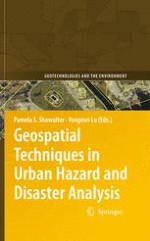2010 | OriginalPaper | Buchkapitel
21. A Planning Support System for Terror-Resistant Urban Communities
verfasst von : Xinhao Wang, Joshua S. Belhadj, Heng Wei
Erschienen in: Geospatial Techniques in Urban Hazard and Disaster Analysis
Verlag: Springer Netherlands
Aktivieren Sie unsere intelligente Suche, um passende Fachinhalte oder Patente zu finden.
Wählen Sie Textabschnitte aus um mit Künstlicher Intelligenz passenden Patente zu finden. powered by
Markieren Sie Textabschnitte, um KI-gestützt weitere passende Inhalte zu finden. powered by
